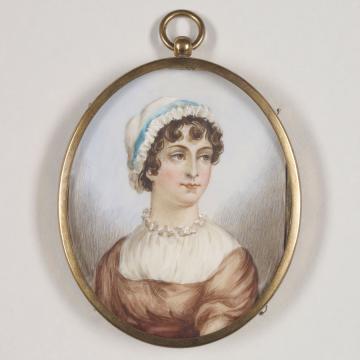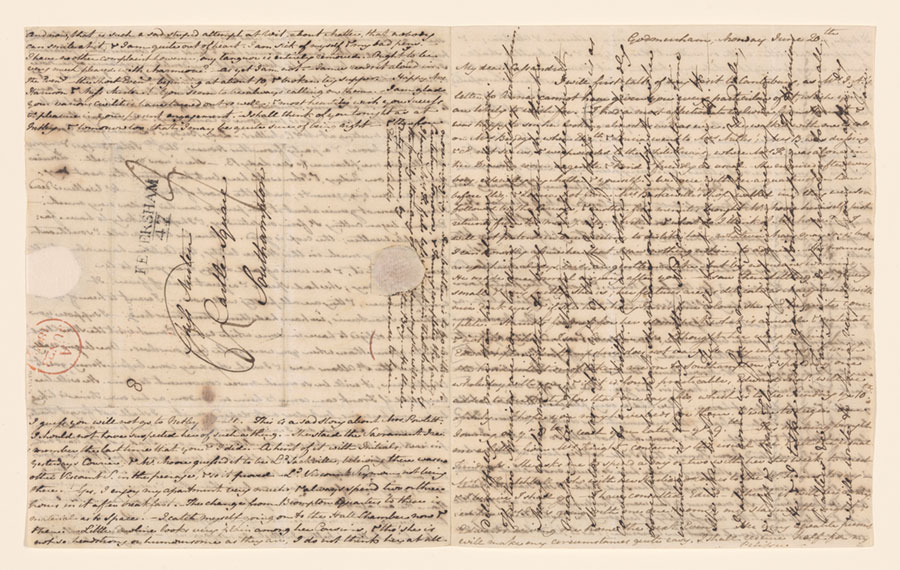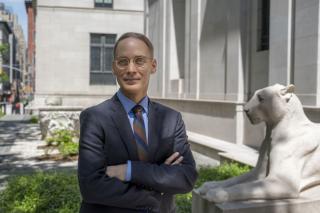In February 2024, Dale Stinchcomb ’16MS became the Drue Heinz Curator of Literary and Historical Manuscripts at the Morgan Library and Museum. For National Library Week 2025, we spoke with him about this unique role, his forthcoming co-curated exhibition on Jane Austen, and the essential training that he received at Simmons.
“The word 'curator' in Latin means someone who takes care of people, institutions, or objects. As a divinity school graduate, I’m always thinking about curating in terms of caretaking,” says Dale Stinchcomb ’16MS, who now serves as the Drue Heinz Curator of Literary and Historical Manuscripts at the Morgan Library and Museum in New York.
Curatorship brings together Stinchcomb’s eclectic intellectual training. He obtained a Master of Library and Information Science: Archives Management concentration at Simmons’ School of Library and Information Science (SLIS). He also pursued graduate studies in religion and literature at the Harvard Divinity School. “My work is very care-focused,” Stinchcomb says. “I’m responsible for a remarkable collection of manuscripts, but I also befriend the people who create and collect them, and serve the community of students and scholars who study them.”
Holistic Curation
“A typical work week for me involves a bit of everything, which keeps the job interesting,” says Stinchcomb. Although the bulk of his time is spent planning exhibitions, any given day he may be hosting a tour with local college students, meeting with donors, guiding researchers in the reading room, or acquiring new objects for the collection from antiquarian books fairs and auctions. Stinchcomb collaborates with his colleagues in conservation, cataloging, development, and marketing.
“It takes a village to mount an exhibition at the Morgan. It’s both a challenge and a thrill,” Stinchcomb says. “While the curator is the driving force behind a show, I rely on the expertise of colleagues from across the institution at every step in the process.”
Stinchcomb joined the Morgan in 2024, when the institution began its year-long centennial celebration. The library opened to the public in 1924 under the leadership of Belle da Costa Greene (1879–1950), J. Pierpont Morgan’s personal librarian and the first director of the Morgan Library. (Currently, Greene is the subject of a major Morgan exhibition, “Belle da Costa Greene: A Librarian’s Legacy,” which runs through May 4). The centennial campaign brought in an astounding group of manuscripts related to Leonardo da Vinci, Queen Elizabeth I, Edgar Allan Poe, and others.
Working with Department Head Philip Palmer, Stinchcomb oversees the Morgan’s literary and historical manuscripts collection. This repository includes handwritten documents from roughly 1500 to the present, including presidential autographs that the institution’s founder, JP Morgan, collected in his youth. The manuscripts are vast and varied, and include the writings, letters, journals, and diaries of famous authors, artists, and historical figures, in addition to illustrations for celebrated children’s books.
“The Morgan’s collection really runs the gamut,” remarks Stinchcomb. “Every day I stumble across some incredible piece of history.”
As Stinchcomb explains, “What the Morgan does exceptionally well is document the creative process in all its messiness. The collection includes working drafts in various states of revision, as well as fair copies [i.e., final copies of manuscripts that went to printers] … Since the days of its first Director, Belle da Costa Greene, the Morgan has been keen on acquiring drafts that show the writer at work.”
Stinchcomb’s curatorship was endowed by Drue Heinz (1915–2018), a British-American actress and prominent literary philanthropist. “I never got to meet Heinz, but since I began working at the Morgan, I’ve run into a few people who have, and had visited her castle in Scotland [where she hosted writers’ retreats]. They have nothing but generous things to say about her,” Stinchcomb says. Heinz’s gift to the Morgan also includes an endowed conservatorship and an acquisition fund.
“For someone like me with an interest in literature and the performing arts, it is gratifying that Heinz endowed this position,” he says.
Celebrating Jane Austen in America

Currently, Stinchcomb is co-curating a forthcoming exhibition entitled “A Lively Mind: Jane Austen at 250” with Professor Juliette Wells, a literary scholar at Goucher College (which began as a women’s college). The exhibition will be on view at the Morgan Library and Museum from June 6 to September 14, 2025.
The exhibition will display approximately 150 items. “It commemorates Austen’s 250th birthday, and it also marks the 50th anniversary of a bequest of Austen manuscripts to the Morgan by the collector Alberta Burke, who was an alumna of Goucher College,” Stinchcomb says. “Burke donated her extraordinary research collection to Goucher, so the two institutions are partnering to highlight her story.”
Moreover, Stinchcomb notes that the Morgan holds the world’s largest collection of Austen manuscripts. Nearly one-third of her surviving letters belong to the Morgan, as well as the only extant complete manuscript of any of Austen’s novels. The exhibition will also display an unauthorized edition of Emma that was published in Philadelphia in 1816, during Austen’s lifetime.
“Jane Austen had readers in North America that she didn’t know about. Since her name does not appear on the title page of Emma, those readers didn’t know who she was either,” Stinchcomb says. “This exhibition will reunite four of the six surviving copies of this edition, and shed light on their owners and readers … Wells’ fascinating discoveries about Austen’s American readers are the inspiration behind the show,” he explains.
Stinchcomb continues, “There is a fun fashion angle too, where we explore Jane Austen’s personal style.” The show will feature period wallpaper from Jane Austen’s House in Chawton, England. Several artifacts from Austen’s home — most of which have never before crossed the Atlantic — will be on display, including her turquoise ring, a hand-copied music book, and a lock of the author’s hair.

Showcasing Hidden Labor
Stinchcomb is also involved in a forthcoming exhibition with fellow SLIS alum Christine Jacobson ’17MS at Harvard University’s Houghton Library, provisionally entitled “Thanks for Typing.”
“This show [opening in January 2026] will examine the forgotten and uncredited women whose labor supported some of the nineteenth and twentieth century’s most influential writers and artists. Specifically, I’m researching the typists who worked behind the scenes churning out scripts for playwrights like Oscar Wilde and George Bernard Shaw. These women were skilled entrepreneurs, often with literary ambitions of their own.”
Stinchcomb elaborates: “As a curator, I’m interested in stories that give us greater insight into how literature and theater are made and that foreground people who have been historically overlooked.”
Stinchcomb came into librarianship purely by happenstance when he was looking for part-time employment as a Harvard Divinity School student. In 2010, he found a job at the Harvard Theatre Collection. Housed within the University’s Houghton Library, this collection was founded in 1901 and constitutes one of the largest theater collections in the world.
“Getting the opportunity at Houghton was one of the best things that ever happened to me,” Stinchcomb recalls. He appreciated expanding his knowledge of the performing arts, specifically the aspects of collaboration among playwrights, directors, actors, costume and set designers, and so forth. The job also inspired him to pursue librarianship as a career. He rose to the rank of Associate Curator of the Harvard Theatre Collection in 2022, and remained there until 2024.
While working at the Houghton, Stinchcomb met many librarians who had trained at Simmons. “My Harvard colleagues said, ‘You need to go to library school, and Simmons is the place to do it.’”
Learning the Curatorial Craft at Simmons
Among his most influential SLIS professors, Stinchcomb fondly remembers Professor and Dean Emerita Michèle Cloonan. “She was my advisor and took me under her wing,” he says.
Cloonan’s husband, faculty member Dr. Sidney Berger, taught a course on the history of the book. “I recall this class vividly because Professor Berger once hosted it at their home,” Stinchcomb recalls. “He and Professor Cloonan had a printing press and built a spectacular collection of rare decorated papers. They were always very generous when students visited them.”
In sum, “the Simmons training was essential,” Stinchcomb says. “It’s hard to progress in this field without a library school degree.”
Stinchcomb advises aspiring curators to “get your foot in the door.” As he elaborates, “When I started, I took the job that was open … and I was thrilled to have it.” While Simmons students and alumnae/i with a graduate degree may expect a job at a certain (i.e., non-entry) level, Stinchcomb learned from his experience at the Houghton Library that any opportunity may lead to a dream job.
Sharing and Caring
Commenting on the joys of his profession, Stinchcomb says, “I love working with students.” Guiding their encounters with archival objects is deeply rewarding, and he also enjoys assisting researchers from all over the world.
Above all, Stinchcomb champions empathy and curiosity. “In my curatorial work, I try to anticipate what visitors experience when they walk into a gallery … what they may not know and what I’d like them to take away,” he explains. “I want to meet people where they are.”
Curiosity entails stepping outside of one’s comfort zone and circumscribed expertise. “But being curious will get you anywhere; you must be willing to continue to learn.”

